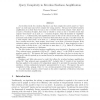Free Online Productivity Tools
i2Speak
i2Symbol
i2OCR
iTex2Img
iWeb2Print
iWeb2Shot
i2Type
iPdf2Split
iPdf2Merge
i2Bopomofo
i2Arabic
i2Style
i2Image
i2PDF
iLatex2Rtf
Sci2ools
ECCC
2010
2010
Query Complexity in Errorless Hardness Amplification
An errorless circuit for a boolean function is one that outputs the correct answer or "don't know" on each input (and never outputs the wrong answer). The goal of errorless hardness amplification is to show that if f has no size s errorless circuit that outputs "don't know" on at most a fraction of inputs, then some f related to f has no size s errorless circuit that outputs "don't know" on at most a 1 - fraction of inputs. Thus the hardness is "amplified" from to 1 -. Unfortunately, this amplification comes at the cost of a loss in circuit size. This is because such results are proven by reductions which show that any size s errorless circuit for f that outputs "don't know" on at most a 1 - fraction of inputs could be used to construct a size s errorless circuit for f that outputs "don't know" on at most a fraction of inputs. If the reduction makes q queries to the hypothesized errorless circuit...
| Added | 10 Dec 2010 |
| Updated | 10 Dec 2010 |
| Type | Journal |
| Year | 2010 |
| Where | ECCC |
| Authors | Thomas Watson |
Comments (0)

